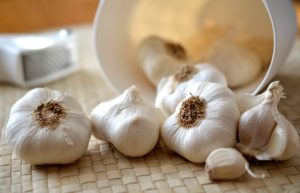Well it’s hard to find folks out there that are not fans of garlic, although they do exist. I, however, am not one of them. There’s a garlic meme that I’ve seen floating out there  and just I had to include it for this post. It is me to a T. While garlic is not new to most any of us, there are always new and inventive ways to include this superfood in your diet. I include it in tomato sauces, in my bone broth, in stuffed peppers, Asian StyleTurkey Lettuce Wraps, and in the fresh gingered beets recipe that my husband loves (it can be found here: Flavors of Health Cookbook
and just I had to include it for this post. It is me to a T. While garlic is not new to most any of us, there are always new and inventive ways to include this superfood in your diet. I include it in tomato sauces, in my bone broth, in stuffed peppers, Asian StyleTurkey Lettuce Wraps, and in the fresh gingered beets recipe that my husband loves (it can be found here: Flavors of Health Cookbook), and in many, many more recipes. Jennifer Tyler Lee suggests roasting garlic because the flavor profile is more tolerable for kids. She also suggests making garlic mushroom toasts. (Again, I would opt for a gluten-free or paleo “bread” option instead of whole wheat toast. See this post for more on why.)
Food Facts:
- Member of the lily family.
- Because garlic has not be breed to be sweeter, larger, or milder tasting, it contains most of its “wild” nutrients.
- All varieties of garlic are quite similar nutritionally.
- Allicin is the active health ingredient in garlic and is a combination of alliin, the protein fragment, and alliinase, the heat-sensitive enzyme. When raw garlic is either cut, pressed, or chewed, these two ingredients are combined. It was discovered that by cooking the garlic immediately after slicing, the heat-sensitive enzyme is destroyed and no allicin is created. Allicin is the active ingredient in garlic that is revered for fighting cancer and protecting the heart. In order to get the most nutrition out of garlic, it is important that you cut/mince/slice/chop the garlic and then let it sit for TEN MINUTES before exposing it to heat.
- A garlic press is the best tool for combining the alliin and alliinase. Jo Robinson says, “press, then rest”.
- Many grocery stores carry garlic grown in China; check where your garlic is coming from. This is frustrating for someone that grocery shops in the same county as Gilroy, the garlic capital of the world. I am a locavore, after all.
- There are two garlic varieties: softneck and hardneck. Hardneck garlic has a hollow stub that protrudes from the top. Softneck garlic appears to have a stem, but it is simply the papery skin that has been twisted.
- Store garlic in the fridge (not the crisper drawer) for the longest shelf life. Until it is cut it will not leave the fridge with bad odors.
- It is native to the Mediterranean, Syria, and China.
- Excellent source of vitamins B6 and C, manganese, and selenium and a good source of phosphorous, calcium, potassium, iron, and copper.
 Has been demonstrated to protect against atherosclerosis, heart disease, elevated cholesterol levels, elevated blood pressure.
Has been demonstrated to protect against atherosclerosis, heart disease, elevated cholesterol levels, elevated blood pressure.- Historically has been used to to fight infections because of its antimicrobial activity.
- Can help protect against colon cancer.
From:
The 52 New Foods Challenge by Jennifer Tyler Lee, Superfoods
by Tonia Reinhard, Eating on the Wild Side
, by Jo Robinson, and Encyclopedia of Healing Foods
by Micheal Murray, Joseph Pizzorno, and Lara Pizzorno.



 Food Facts:
Food Facts: